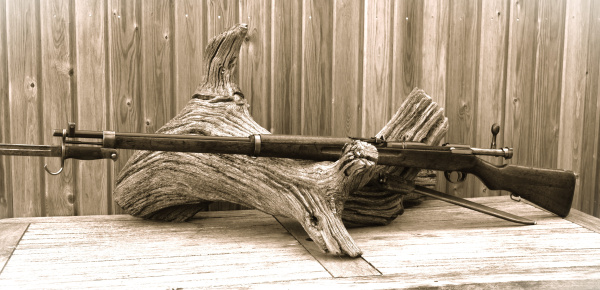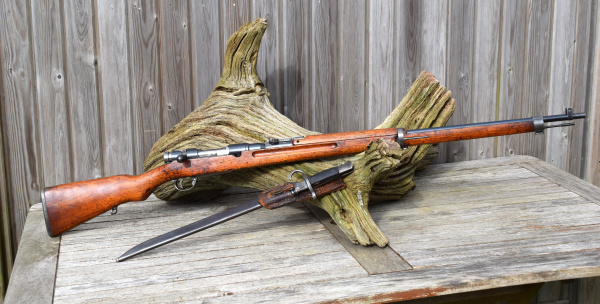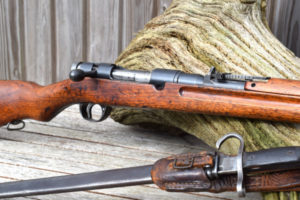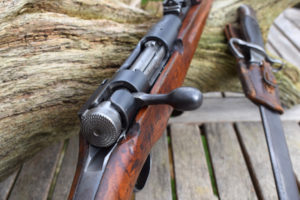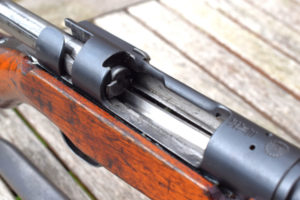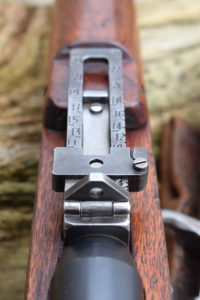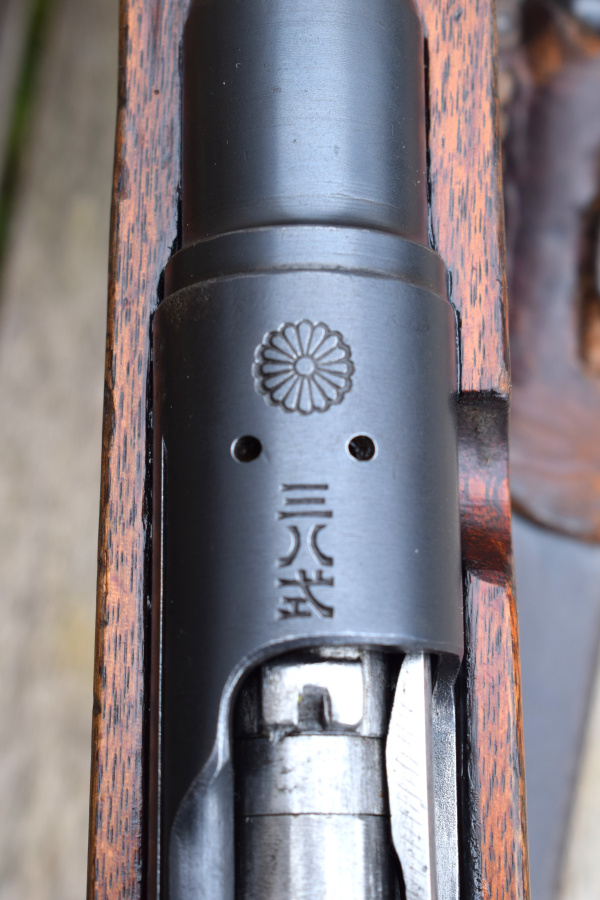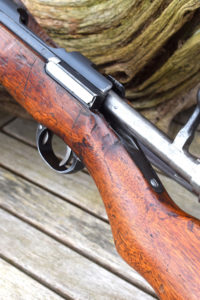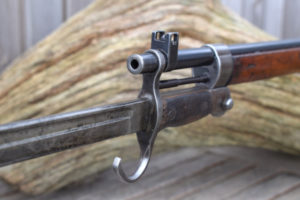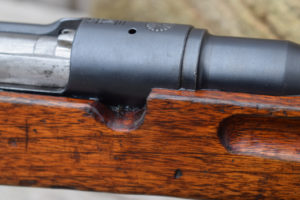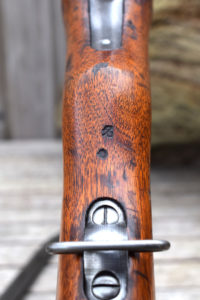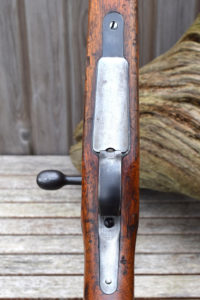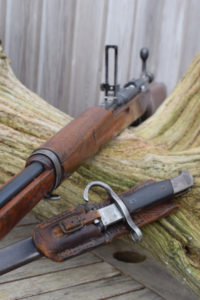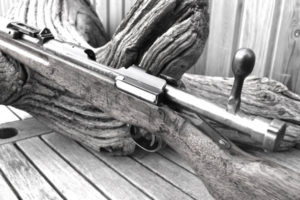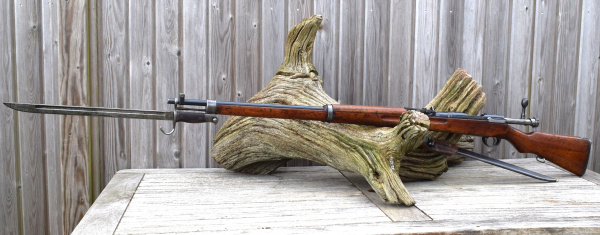Type 38 (Meiji) Arisaka Full length Infantry Rifle……..(F 1186)
Created on March 13th 2025
Type 38 Arisaka Rifle by Nagoya Arsenal
Full length Imperial Japanese Army Infantry Rifle. Designed and built from 1905 onwards. Chambered in 6.5mm Japanese with a strong Mauser based action with a 5-shot internal magazine. This rifle is complete with its Mum intact but the dust cover discarded. This is the main rifle encountered during the second world war in the hands of the Imperial Army. When the bayonet is attached it transforms into a formidible 65″ long weapon. The caliber is an accurate “shooter” and many a “sniper” left behind to hinder the US troops advancements, were found with these and no scopes, just open sights. Also, often used in last hope, fanatical bayonet charges, these still presented a weapon an American Infantryman would rather not get too close to.
The rifle itself measures 50.1/4″ in overall length. The round blued barrel is 31.1/2″ long and the Pull length is 13″ to centre. The round blued receiver shows a clear undisturbed Imperial Japanese Mum over two gas escape holes and then the clear Japanese markings for Type 38 arranged vertically. The LH outer wall of the receiver shows the serial number “22406” with an arsenal marking for “Nagoya” (1923 to 1945) and on the RHS of the same a smaller circled mark for the kana or series. (Undetermined) The action and barrel are blued with a high degree of strong original finish. There is a very small patch of light pitting on the front of the receiver ring LHS just next to the barrel step or shoulder. This indicates that it has not been refinished. The bolt with its characteristic Mushroom head safety was finished in the white. The steel has darkened due to contact with human hands over the ovaloid bolt knob, but otherwise remains fairly bright. The number from another rifle is stamped into the bolt stem.
The rear of the bolt safety has a fine geometric pattern machined into the surface of the head. This can be depressed by the open palm and turned from the 11 o’clock position to the 12 o’clock position to apply the safety. There is a pointer on the outside which indicates its relative positioning. The Japanese military had decided the conventional flag type safeties would be difficult to apply in wet conditions and it would be easier with the open palm. It is actually very easy once you have got used to it. Another reason may be the propensity of the Japanese soldier in the field to eat with his fingers – imagine the fumbling that could occur trying to operate the safety with slippery fingers! The action has the normal Mauser type arrangement for withdrawal of the bolt on the rear LHS.
The rear ladder sights include a close-range circular aperture sight which is usable when the ladder is lain flat, for close quarter fighting. When in the upright position the same will slide up the ladder to a chosen range for more distant shots. The ladder is graduated from 500 to 2400 meters upon its face. There is no windage adjustment on either front or rear sights. Although, upon zeroing on the range, the rifle could be adjusted by drifting the front dovetailed inverted V sight. The front sight is protected from dislodgment in use.
Underneath the barrel is a long cleaning rod retained by a spring catch behind the nosecap. The nosecap also incorporates a bayonet lug. The mid barrel band is held in position by a Gew’-type spring arrangement and has the forward sling swivel beneath it. A rear sling swivel sits behind the very slight pistol grip bump of the stock. Steel butt-plate over the end of the two piece butt-stock. The Japanese used a two piece butt-stock design held together by a longitudinal dovetail joint to save timber. This joint is very tight and almost undectable. The fore-end has 8″ finger grooves placed beneath the rear sights. The stock in general, is in very good condition with the normal amount of “military life” damage showing on its surface. There are two possibly three very small but quite deep stock makers marks on the underside of the butt. Alongside the reciver is a distinct deep groove carved away from the straight waterline of the stock contour; this is a water run-off groove – another clever Japanese idea bourne out of their familiarity with warfare in that part of the world.
The rifle was imported from the USA last year. It has been stripped, cleaned, re-head spaced and proofed to UK CIP standards. It is ready for its next keeper. Any serious shooter interested in weapons that the Axis troops were equiped with, should seriously consider experiencing one of these fine rifles. As a side; experiments have been made upon bolt action rifles of the era and the Arisakas have been found to posses the strongest action of any – stubbornly refusing to be blown up! Rare with intact an Mum. Very good RH twist bore with Polygonal rifling, no pitting to the Mk 1 eyeball and no misting. Chamber freshly reamed.
Stock No 1186 – FAC required
Bayonet available @ £275. but not included.
£ 1175.
Comments Off on Type 38 (Meiji) Arisaka Full length Infantry Rifle……..(F 1186)
